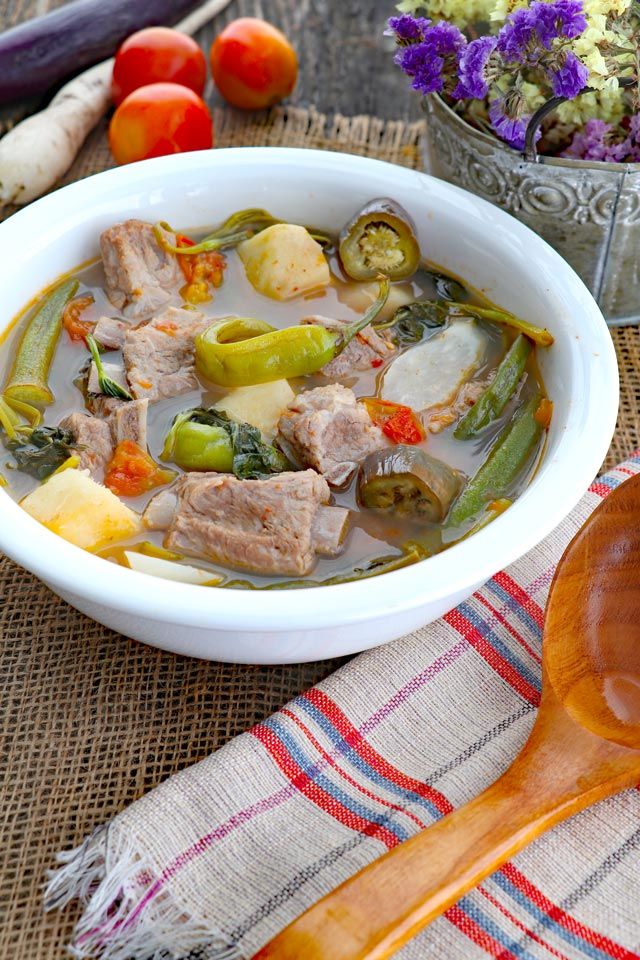Your friendly next-door hubadera.
When it starts to rain, nothing’s comfier than a piping-hot bowl of sour sinigang na baboy.
But not everyone knows how to cook the classic sinigang na baboy with gabi or has mastered the sinigang na baboy sa sampalok recipe.
The thing about sinigang recipes is they’re easy to do.
You throw in all the ingredients (save for one; to add later), leave it alone for a while, and let chemistry do its thing in developing the full flavor of this super comforting dish — especially on a cold, gloomy day.
If you don’t know how to make sinigang na baboy from scratch and think using real sampalok is hella hard, think again. You just need to get everything organized in the kitchen. Prep well, and you’ll find that cooking homemade sinigang without the mix is the better dish because of the bright sourness and light citrus taste from your fresh souring ingredient. It’s also healthy cooking because it’s natural and contains less sodium.
So here’s a basic recipe that uses real sampalok.
Ingredients

- 1kg pork (your choice of cut, but I recommend pork liempo cut into 1-inch cubes)
- Unripe tamarind (sampalok)
- 2 tomatoes, ripe
- 1 medium-sized red onion, peeled and quartered
- 3 cloves garlic, crushed and peeled
- 3 finger chillies (siling haba)
- 1 radish (labanos), sliced into rounds
- 1 eggplant, sliced into rounds
- 8 bundles of kangkong (stalks and leaves separate)
Prep Time: 15 minutes
Cooking Time: 30 minutes
Difficulty Level: Beginner
Serves: 4-5
How to Cook Sinigang na Baboy
- Wash and drain the meat. Wash and prepare your vegetables.
- Place unripe tamarind in water and bring to boil. Once boiled, let cool and then strain the juice out with spoon pushing against the softened tamarind. Set the juice aside.
- Boil the pork with the tomatoes in water until the pork is tender. To check, use a fork to pierce through the meat. It should easily puncture the pork. Remove the scum that floats on the surface.
- Once the meat is tender, crush the tomatoes. You can either crush them in the broth, or remove them from the broth, crush them, and then toss the pulp back into the pot.
- Add the onions, garlic, and finger chillies all at once. Wait for the broth to boil.
- Once you bring the broth back to a boil, add your tamarind juice. The amount would depend on your sour level preference. Taste to test.
- Add your radish.
- Once the radish rounds are tender, add your eggplants.
- Once the eggplant slices are tender, add your kangkong stalks.
- Once the stalks are tender, add your kangkong leaves.
- Wait for the broth to boil, then simmer for 2-3 minutes. Give it one last taste for seasoning, adjust as necessary, and serve.
Sinigang na Baboy Trivia while Waiting for the Broth to Boil

It’s cooked here long before the Spaniards came. A lot of food historians believe that sinigang pre-dates the Spanish colonization. It is, after all, evident in the very name of the dish: sinigang is the Tagalog word for “stew.” Not to mention the dish uses ingredients that are easily found here.
Variations abound. Sinigang na baboy is but one of many variations of sinigang. You have the popular ones, sinigang sa sampalok, which uses tamarind as a souring agent. Then you have sinigang sa kalamansi, sa miso, sa kamias (ginger lily), sa bayabas (guava), and sa mangga (unripe mango). It could be cooked with shimp, fish, beef, and more. There’s also vegan sinigang, which uses no meat at all.
It’s endlessly reinvented. The classic variations are fool-proof, but Filipinos never run out of ways to give sinigang a new twist. There’s sinigang na corned beef, where you can add your favorite canned good. I’ve tasted the watermelon sinigang, which is sweeter and less sour.
Sinigang Rice is a personal favorite, perfect with bagnet or fried chicken.
If you can’t get a hold of fresh sampalok (it’s in season from October to December), then go ahead and reach for that sinigang mix.
Once you’ve mastered this sinigang na baboy recipe, you’re on your way to making your own reinventions, too.
What's Your Reaction?
Your friendly next-door hubadera.

